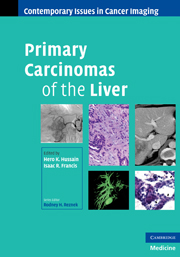Book contents
- Frontmatter
- Contents
- Contributors
- Series foreword
- Preface to Primary Carcinomas of the Liver
- 1 Epidemiology of hepatocellular carcinoma and cholangiocarcinoma
- 2 Surveillance and screening for hepatocellular carcinoma
- 3 Pathology of hepatocellular carcinoma, cholangiocarcinoma, and combined hepatocellular-cholangiocarcinoma
- 4 Radiological diagnosis of hepatocellular carcinoma
- 5 Staging of hepatocellular carcinoma
- 6 Surgical treatment of hepatocellular carcinoma: resection and transplantation
- 7 Non-surgical treatment of hepatocellular carcinoma
- 8 Radiological identification of residual and recurrent hepatocellular carcinoma
- 9 Radiological diagnosis of cholangiocarcinoma
- 10 Staging of cholangiocarcinoma
- 11 Treatment of cholangiocarcinoma
- 12 Uncommon hepatic tumors
- Index
- Color plates
- References
9 - Radiological diagnosis of cholangiocarcinoma
Published online by Cambridge University Press: 04 August 2010
- Frontmatter
- Contents
- Contributors
- Series foreword
- Preface to Primary Carcinomas of the Liver
- 1 Epidemiology of hepatocellular carcinoma and cholangiocarcinoma
- 2 Surveillance and screening for hepatocellular carcinoma
- 3 Pathology of hepatocellular carcinoma, cholangiocarcinoma, and combined hepatocellular-cholangiocarcinoma
- 4 Radiological diagnosis of hepatocellular carcinoma
- 5 Staging of hepatocellular carcinoma
- 6 Surgical treatment of hepatocellular carcinoma: resection and transplantation
- 7 Non-surgical treatment of hepatocellular carcinoma
- 8 Radiological identification of residual and recurrent hepatocellular carcinoma
- 9 Radiological diagnosis of cholangiocarcinoma
- 10 Staging of cholangiocarcinoma
- 11 Treatment of cholangiocarcinoma
- 12 Uncommon hepatic tumors
- Index
- Color plates
- References
Summary
Cholangiocarcinomas are tumors that arise from the bile duct epithelium anywhere from the liver to the ampulla of Vater. Intrahepatic cholangiocarcinoma accounts for 5–30% of all primary malignant hepatic tumors, and is the second most common primary malignant tumor of the liver after hepatocellular carcinoma (HCC). More than 90% of cholangiocarcinomas are adenocarcinomas. Other tumor types have been described. The histological grade of tumors varies from well-differentiated to undifferentiated. Most tumors consist of clusters of cells, surrounded by desmoplastic stroma, which can be extensive. The latter feature makes it difficult to distinguish between reactive tissue and well-differentiated cholangiocarcinoma. Furthermore, intrahepatic cholangiocarcinoma may be confused with metastatic scirrhous carcinoma on liver biopsy. Therefore, a primary adenocarcinoma as a source for metastases should be excluded when considering an intrahepatic cholangiocarcinoma.
Cholangiocarcinoma is more common in men than women, occurring most frequently between the sixth and seventh decades. Most patients have no predisposing risk factors, but primary sclerosing cholangitis (PSC) (5–15% lifetime risk), choledochal cysts (5% will transform and risk increases with age), Caroli's disease (7% lifetime risk), hepatolithiasis, chronic intraductal stones, bile duct adenoma, biliary papillomatosis, Clonorchis sinensis infection, and Thorotrast (thorium dioxide) exposure are some of the risk factors for cholangiocarcinoma. A higher prevalence of positive anti-hepatitis C virus has also been associated with cholangiocarcinoma.
- Type
- Chapter
- Information
- Primary Carcinomas of the Liver , pp. 136 - 159Publisher: Cambridge University PressPrint publication year: 2009
References
- 1
- Cited by



